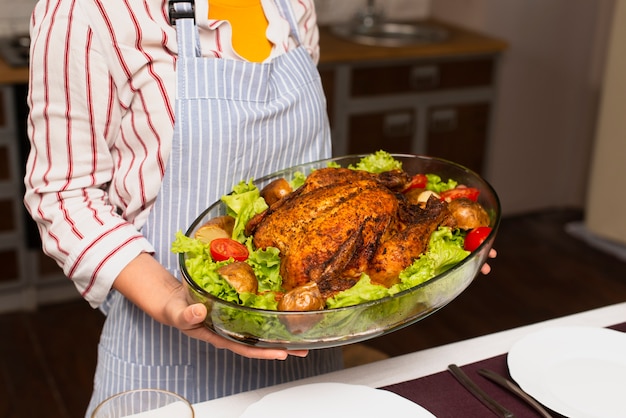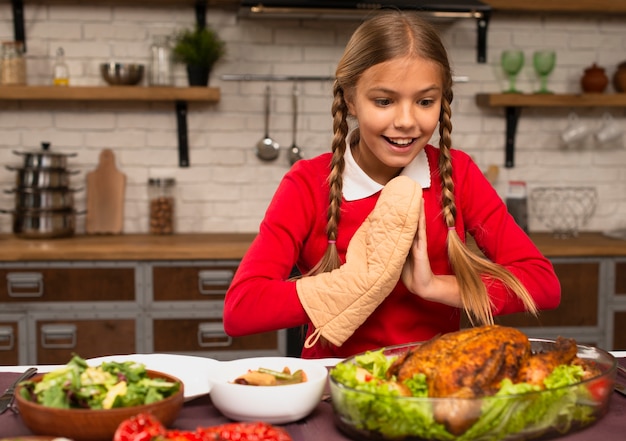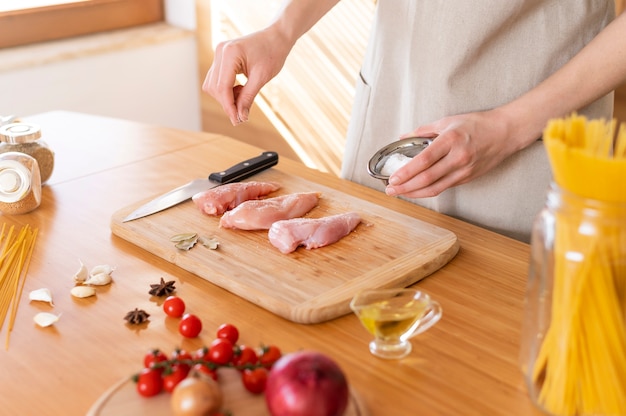Let's face it, cooking chicken can be a bit nerve-wracking. You want it to be perfectly cooked, but nobody wants a dry, rubbery bird. I've had my fair share of triumphs and disasters in the kitchen, but one thing I've learned is that getting the temperature just right is absolutely crucial. So, grab your apron, because I'm about to share everything I know about cooking chicken to perfection.
(Part 1) The Science Behind chicken safety: Understanding the Risks

Why Temperature Matters: A Tale of Salmonella
Chicken, though delicious, can harbor a pesky little bacteria called Salmonella. This bacteria is a real party pooper, potentially causing food poisoning with symptoms ranging from a mild stomach ache to a full-blown bout of vomiting and diarrhea. That's why we need to ensure the internal temperature of chicken reaches a certain level to kill off any lurking Salmonella. Think of it like a little battle, and we want to make sure our good guy, the heat, wins.The Golden Rule: 165°F (74°C): A Crucial Threshold
The USDA (United States Department of Agriculture) recommends cooking all poultry, including chicken, to an internal temperature of 165°F (74°C). This is the magic number. It's the temperature that guarantees the elimination of harmful bacteria, making your chicken safe for consumption.(Part 2) Tools of the Trade: Your Chicken Cooking Arsenal

The Essential Thermometer: A Kitchen Hero
Let me be clear: a meat thermometer is your best friend. It's like a little superhero in the kitchen, preventing undercooked chicken and the subsequent stomach ache. I swear by my instant-read thermometer, the kind with a long, thin probe. It gives me a reading in seconds, letting me know, with complete confidence, that my chicken is cooked to perfection.Choosing the Right Thermometer: Navigating the Options
You might be wondering, "Which thermometer should I get?" There are several types available, each with its own strengths. Here's my breakdown: Instant-read: This is my go-to. It's quick and easy to use, perfect for checking the internal temperature of your chicken. Oven-safe: This thermometer stays in the food as it cooks, eliminating the need to constantly open the oven and peek inside. Wireless: These are a bit fancier, sending you a notification when your chicken reaches the desired temperature. It's a bit of a luxury, but it can be super handy.Other kitchen essentials: Completing Your Toolkit
Besides a thermometer, here are some other tools that will make your chicken-cooking journey smoother: A Sharp Knife: This is essential for cutting the chicken into even pieces, ensuring even cooking and preventing some parts from being overcooked while others remain undercooked. A Cutting Board: A clean cutting board will protect your kitchen surfaces and prevent cross-contamination. A Baking Sheet: This is great for roasting chicken and helps to contain any splatter in the oven.(Part 3) Cooking Methods: A Chicken Lover's Guide

Roasting: A Classic Choice for whole chickens
Roasting is a classic method for cooking a whole chicken or large pieces. It's all about even cooking and achieving juicy results.roasting tips: Master the Art of Roasted Chicken
Pre-heating: Start with a preheated oven – this is crucial for that lovely golden brown skin. Brining: Brining your chicken before roasting can make it extra tender and juicy. Simply soak it in a salt water solution for a few hours. It's a little extra effort, but the results are worth it. Seasoning: Don't be shy with the seasonings! Herbs, spices, and a touch of citrus zest can really elevate the flavour. Experiment and find your favourite flavour combinations.Pan-frying: Quick and Easy for chicken breasts and Thighs
Pan-frying is a fantastic option when you're short on time. It's perfect for chicken breasts or thighs and can give you a beautiful crispy skin.Pan-frying Tips: Achieving Crispy Perfection
High Heat: Start with a hot pan – this helps to create that crispy exterior. Don’t overcrowd the pan: Give the pieces some space to brown evenly. Overcrowding leads to steaming instead of browning. Flip Once: Flip the chicken only once to prevent it from drying out. You want to ensure the inside is cooked without making the outside too tough.Baking: Simple and Reliable for tender chicken
Baking is a hassle-free approach to cooking chicken. It's easy to control the temperature and the chicken comes out beautifully cooked.baking tips: For a Simple and Delicious Bake
Grease the pan: A little oil or butter helps to prevent sticking. Cover with foil: Covering the chicken with foil for the first part of the baking time helps to keep it moist. Uncover for browning: Remove the foil towards the end of cooking to allow the skin to crisp up.Grilling: A Summertime Delight for a Smoky Flavour
grilling chicken screams summertime fun. It's perfect for outdoor gatherings and adds a smoky, charred flavour.grilling tips: Mastering the Art of grilled chicken
Indirect heat: For more even cooking, use indirect heat, which means keeping the chicken away from the direct flames. This will prevent the outside from burning before the inside is cooked. Marinade: A marinade can really enhance the flavour of grilled chicken, so experiment with different combinations of herbs, spices, and citrus. Flip once: Like pan-frying, flip the chicken only once to avoid drying it out.(Part 4) Chicken Cuts: A Guide to Understanding Your Bird
Whole Chicken: A Feast for Everyone
A whole chicken is a classic choice for a family dinner or a special occasion. It's versatile, and you can roast it, grill it, or even bake it.Chicken Breasts: The Lean and Versatile Choice
Chicken breasts are a lean, versatile cut that's great for grilling, pan-frying, or baking. They're perfect for quick and easy weeknight meals.chicken thighs: A Juicy and Flavourful Treat
Chicken thighs are known for their juicy, flavorful taste. They have a higher fat content than breasts, which helps to keep them moist during cooking. They're fantastic for roasting or pan-frying.chicken wings: The Party Favourite
Chicken wings are a beloved party food, and they can be baked, fried, or grilled. Get creative with your wing sauces and enjoy!(Part 5) how to tell if chicken is cooked Through: Doneness Clues
The Thermometer Test: Your Best Friend
As I mentioned before, using a meat thermometer is absolutely crucial for checking the internal temperature of your chicken. Simply insert the probe into the thickest part of the chicken, avoiding bones, and make sure it reads 165°F (74°C).The Visual Test: Signs of Doneness
You can also look for visual clues to determine if your chicken is cooked through: The Colour: Cooked chicken should have a white, opaque appearance. The center should be white, not pink. The Juice: When you cut into the chicken, the juices should run clear, not pink. Pink juices indicate that the chicken is not cooked through. The Texture: The chicken should be firm to the touch and not jiggly. It should spring back when you press on it.(Part 6) What to Do with Overcooked Chicken: Salvaging a Dry Bird
Not All Hope Is Lost: A Guide to Rehydration
Okay, so we've all been there – you've cooked the chicken a little too long, and it's starting to look a bit dry. But don't despair! There are a few things you can do to salvage the situation.Add Moisture: The Trick to Reviving Dry Chicken
The key is to add moisture back into the overcooked chicken. Here are a few tips: Use a Sauce: A rich sauce can help to mask the dryness and add flavour. Add Liquid: Adding a little broth or stock to the pan can also help to rehydrate the chicken. Cover with Foil: Covering the chicken with foil during cooking or even after cooking can help to trap in the moisture.(Part 7) chicken cooking mistakes: How to Avoid Them
Overcrowding the Pan: A Common Error
One of the biggest mistakes people make is overcrowding the pan when cooking chicken. This can lead to uneven cooking, and the chicken might not reach the safe internal temperature. Always ensure there's space for the chicken to brown and cook evenly.Not Letting It Rest: A Big No-No
Another common mistake is not letting the chicken rest after cooking. Resting allows the juices to redistribute, resulting in a more tender and juicy piece of chicken. Give it a minimum of 5-10 minutes to rest before carving or serving.Not Checking the Temperature: A Crucial Oversight
I can't stress this enough: always check the internal temperature of your chicken using a meat thermometer. It’s the only way to ensure that it’s cooked through and safe to eat.(Part 8) Chicken Storage and Handling: Keeping It Safe
Refrigeration: A Must-Do
Always store raw chicken in the refrigerator at 40°F (4°C) or below. It should be kept in a sealed container or wrapped tightly in plastic wrap to prevent cross-contamination.Freezing: An Option for Later
You can freeze chicken for up to two months. Wrap it tightly in freezer paper or plastic wrap to prevent freezer burn.Thawing: Safely and Carefully
When thawing chicken, do so safely by placing it in the refrigerator overnight or by submerging it in cold water. Never thaw chicken at room temperature. This can create a breeding ground for bacteria.(Part 9) chicken recipes: Inspirations for Every Occasion
Classic Roasted Chicken: A Timeless Favourite
This recipe is a crowd-pleaser and perfect for a weeknight dinner or a special occasion.Ingredients:
- 1 whole chicken, about 4 pounds (1.8 kg)
- 1 tablespoon olive oil
- 1 teaspoon salt
- 1/2 teaspoon black pepper
- 1/4 cup chopped herbs, such as rosemary, thyme, and sage
- 1/2 lemon, cut into wedges
Instructions:
- Preheat oven to 400°F (200°C).
- Rub the chicken inside and out with the olive oil, salt, pepper, and herbs.
- Place the chicken in a roasting pan and stuff the cavity with the lemon wedges.
- Roast for 1 hour and 15 minutes, or until the internal temperature reaches 165°F (74°C).
- Let the chicken rest for 10 minutes before carving.
pan-fried chicken Breasts: Simple and Delicious
This recipe is perfect for a quick and easy weeknight meal.Ingredients:
- 2 boneless, skinless chicken breasts
- 1 tablespoon olive oil
- 1/2 teaspoon salt
- 1/4 teaspoon black pepper
Instructions:
- Heat the olive oil in a large skillet over medium-high heat.
- Season the chicken breasts with salt and pepper.
- Add the chicken breasts to the skillet and cook for 4-5 minutes per side, or until golden brown and cooked through.
- Let the chicken rest for 5 minutes before slicing and serving.
Grilled Chicken with Lemon Herb Marinade: A Summertime Delight
This recipe is perfect for outdoor gatherings and adds a smoky, charred flavour to the chicken.Ingredients:
- 4 boneless, skinless chicken breasts
- 1/2 cup olive oil
- 1/4 cup lemon juice
- 2 cloves garlic, minced
- 1 tablespoon chopped fresh herbs, such as rosemary, thyme, and parsley
- 1 teaspoon salt
- 1/2 teaspoon black pepper
Instructions:
- In a large bowl, whisk together the olive oil, lemon juice, garlic, herbs, salt, and pepper.
- Add the chicken breasts to the marinade and toss to coat.
- Marinate for at least 30 minutes, or up to 4 hours.
- Preheat grill to medium heat.
- Remove the chicken from the marinade and discard the marinade.
- Grill the chicken for 5-7 minutes per side, or until cooked through.
- Let the chicken rest for 5 minutes before slicing and serving.
(Part 10) FAQs: Your Chicken Cooking Queries Answered
1. Can I Use a Meat Thermometer to Check the Temperature of frozen chicken?
It's not recommended to use a meat thermometer on frozen chicken because the frozen center can give you an inaccurate reading. It's best to thaw the chicken completely before checking the internal temperature.2. How Long Can I Keep Cooked Chicken in the Fridge?
Cooked chicken can be stored in the refrigerator for 3-4 days. It's important to refrigerate it promptly after cooking and reheat it thoroughly before eating.3. What's the Difference Between Dark Meat and White Meat?
Dark meat, like chicken thighs and legs, has more fat and is generally more flavorful and juicy than white meat, like chicken breasts. This is due to the higher concentration of myoglobin in dark meat, which gives it its darker color and richer flavor.4. What Should I Do If My Chicken Is Still Pink After Cooking?
If your chicken is still pink after cooking, it's crucial to check the internal temperature using a meat thermometer. If it hasn't reached 165°F (74°C), it needs to be cooked further. The pink color doesn't always indicate that the chicken is undercooked. It could be the result of the pigment myoglobin, which is naturally present in chicken.5. Can I Cook Chicken in a slow cooker?
Yes, you can cook chicken in a slow cooker. It's a great way to achieve tender and juicy results. Just make sure to cook the chicken on low heat for at least 6 hours or on high heat for 3-4 hours. Chicken cooked in a slow cooker can be used in various recipes like soups, stews, or pulled chicken sandwiches.Remember, cooking chicken is all about precision and patience. By following these tips and tricks, you'll be able to cook chicken to perfection every time. So go forth, embrace the joys of chicken cooking, and enjoy delicious, safe, and perfectly cooked meals!Everyone is watching

Corn on the Cob: The Ultimate Guide to Perfectly Cooked Ears
Healthy MealsAh, corn on the cob. Just the name evokes images of sunny days, barbecues, and that sweet, juicy flavour that ...

Perfect Pork Roast Oven Cooking Time: A Guide to Delicious Results
Healthy MealsThere's something truly satisfying about a perfectly roasted pork. The aroma alone is enough to make your mout...

Ham Cooking Time: How Long to Bake, Smoke, or Boil a Delicious Ham
Healthy MealsAh, ham. It's a classic, isn't it? A real crowd-pleaser, especially around holidays. And when done right, it'...

Scallops: The Ultimate Guide to Perfect Cooking
Healthy MealsAh, scallops. Those delicate, sweet, and utterly delicious morsels of the sea. They hold a special place in my...

Spaghetti Squash: The Ultimate Guide to Cooking and Serving
Healthy MealsRemember that time you saw spaghetti squash at the supermarket, looking all bumpy and strange, and thought, "W...
